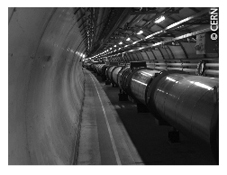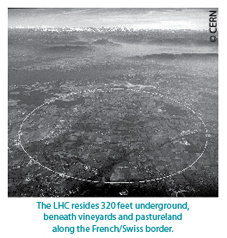In Pursuit of the God Particle
 The large hadron collider, the atom smasher sitting beneath Geneva, Switzerland, is the largest and most expensive scientific instrument ever built. On September 10, 2008, it succeeded in sending beams of protons all the way around a sixteen-mile tunnel. A few weeks later it encountered technical difficulties, which shouldn’t be surprising for a machine of a million parts put together with a million welds. After the helium used to cool the collider’s apparatus leaked into the tunnel, engineers at the European Organization for Nuclear Research (CERN) announced the LHC would be down for two months. But come spring the LHC will be back colliding protons in its billion-dollar detectors. And when it does it won’t be producing any “God particles” or spawning black holes that eat the Earth. It will, however, be creating something like hell.
The large hadron collider, the atom smasher sitting beneath Geneva, Switzerland, is the largest and most expensive scientific instrument ever built. On September 10, 2008, it succeeded in sending beams of protons all the way around a sixteen-mile tunnel. A few weeks later it encountered technical difficulties, which shouldn’t be surprising for a machine of a million parts put together with a million welds. After the helium used to cool the collider’s apparatus leaked into the tunnel, engineers at the European Organization for Nuclear Research (CERN) announced the LHC would be down for two months. But come spring the LHC will be back colliding protons in its billion-dollar detectors. And when it does it won’t be producing any “God particles” or spawning black holes that eat the Earth. It will, however, be creating something like hell.
The LHC is to inner space what the Hubble Space Telescope is to outer space. Both explore an extreme range. The telescope looks for unusual galaxies at distances of billions of light years, while the collider looks for unusual new particles or unexpected forces operating at a distance scale of a billionth of a billionth of a meter. With the telescope you focus emissions from the galaxy with a highly polished mirror, record the light in an electronic detector, and then beam the data back to Earth. With the collider, retrieving data and interpreting results is a bit trickier.
Part of what makes the LHC tricky, but also quite interesting, is that knowledge is gained by producing a hellishly harsh environment. At several points around the sixteen-mile tunnel, two beams of protons are crashed into each other. And where two such protons meet head on, a miniature fireball is created. At a temperature of billions or trillions of degrees this is, for a tiny slice of a second, the hottest place in the solar system, far hotter and far denser than the core of the sun.
The rationale for the smashups and for the high temperatures comes from the idea that energy can be converted from one form into another. The protons at the LHC whiz around their long track at a speed of 99.999999 percent of the speed of light. When the two beams hit each other, a lot of their immense energy of motion can, at the moment of collision, be transformed into new particles that weren’t there a moment before.
When two automobiles hit head on the results are always bad. But in the world of high-energy physics, instigating a violent smashup with lots of debris spraying out is exactly what researchers want. Among the debris can be particles that might have existed billions of years ago but which, because of their instability, have long ago decayed. According to modern cosmology, the universe continues to cool and expand. A big part of a modern particle physics experiment is devoted to reversing this universal trend in selected little pockets of space. The fireball ignited at the collision point represents a tiny recreation of the earlier universe. Physicists do this not for reasons of nostalgia but because in the primitive, hotter cosmos there was more energy about, and certain configurations of matter not possible now could thrive. Imagine being a paleontologist with the ability to recreate 100-million-year-old living conditions to see what dinosaurs really looked like. The LHC then becomes a Jurassic Park for physics.
 Among the most sought-after “dinosaurs” for particle physicists is the Higgs boson. This particle, called the “God particle” by Nobelist Leon Lederman (who, rumor has it, was told he would sell more copies of his book if he used this as the title), plays an important role in thinking about the hidden properties of physics. The Higgs supposedly helps to endow many other particles in nature with the mass they possess. And since to be massless is practically to be non-existent, the giving of mass is a highly creative process. You can start to see why Lederman, his marketing motivation aside, was tempted to call this the God particle.
Among the most sought-after “dinosaurs” for particle physicists is the Higgs boson. This particle, called the “God particle” by Nobelist Leon Lederman (who, rumor has it, was told he would sell more copies of his book if he used this as the title), plays an important role in thinking about the hidden properties of physics. The Higgs supposedly helps to endow many other particles in nature with the mass they possess. And since to be massless is practically to be non-existent, the giving of mass is a highly creative process. You can start to see why Lederman, his marketing motivation aside, was tempted to call this the God particle.
How does the Higgs bestow mass? An electron, for example, might well have no mass at all except that it swims in an all-pervasive sea of Higgs bosons; the result of interactions with this sea, argues the standard model of particle physics, makes the electrons heavier. This isn’t any literal sea, but a virtual sea that resides in the universal vacuum. The electron can sense this sea, but we can’t. At least not normally. In a violent-enough collision between two protons at LHC, however, it is likely that we can flush one of the Higgs particles out of the virtual sea and into the open where it can be detected. Actually being so unstable, the Higgs will probably decay into a flash of daughter particles which, when glimpsed and analyzed, provide us with evidence about the Higgs during its very short life at LHC.
Another quarry at the LHC is miniature black holes. A black hole is a celestial object, thought to be created when old stars collapse into a tight volume of space. The gravity exerted by the holes is so great that anything that passes inside of them can’t get out. Why should we want to make black holes on Earth? Because we can, and because they might reveal more physics secrets. Aren’t they dangerous? Well, responsible studies have been made of the possibility that a mini black hole, once unloosed, could gobble up more and more matter. Fortunately, this fear has been laid to rest. Mini black holes, like most of the other interesting new particles to be made at the LHC, will only live for a billionth of a trillionth of a second or less before fragmenting into more normal particles.
Rather than something to dread, the making of a tiny black hole or the discovery of evidence for an extra spatial dimension or other extinct category of matter is something to be welcomed. The making of bizarre or never-before-seen particles, like dredging up new species from the bottom of the ocean or finding lifeforms on distant moons, helps to expand our notion of the universe. That’s why taxpayers in Europe and elsewhere (the U.S. contribution to LHC is quite large) spent billions of Euros to fill a Swiss tunnel with fast, state-of-the-art electronic equipment. The research at LHC is patently driven by curiosity–the hope being to widen our sense of what existence is–but, if experience is any guide, we should also reap a rich harvest of practical applications. Many of the things we take for granted–our computers, cell phones, medical scanners that hunt for tumors, solar-cell-powered water pumps in rural areas–are possible only because science had for years and decades explored nature at the deepest possible level. The odds are high that, like the continental explorers of the past, the LHC will identify new terrain. These new lands might only be a nanometer across. And they may not be exactly where we expected them to be, but their discovery might have an equally big impact on our species as the discovery of the Western Hemisphere.
The very existence of the Large Hadron Collider as the product of an international effort that includes the United States should be celebrated as a clear validation of science and the value of scientific enterprise. Before LHC took over the title of most powerful collider, that distinction was held by the Fermi National Accelerator Lab near Chicago, site of many physics discoveries of its own. When Robert Wilson, Fermilab’s first director, was asked in a Senate hearing (at the height of the Vietnam war) whether the prospective lab would contribute to the national defense, his answer was short but sweet: No, it won’t contribute directly to the national defense but it will make this a nation worth defending.
